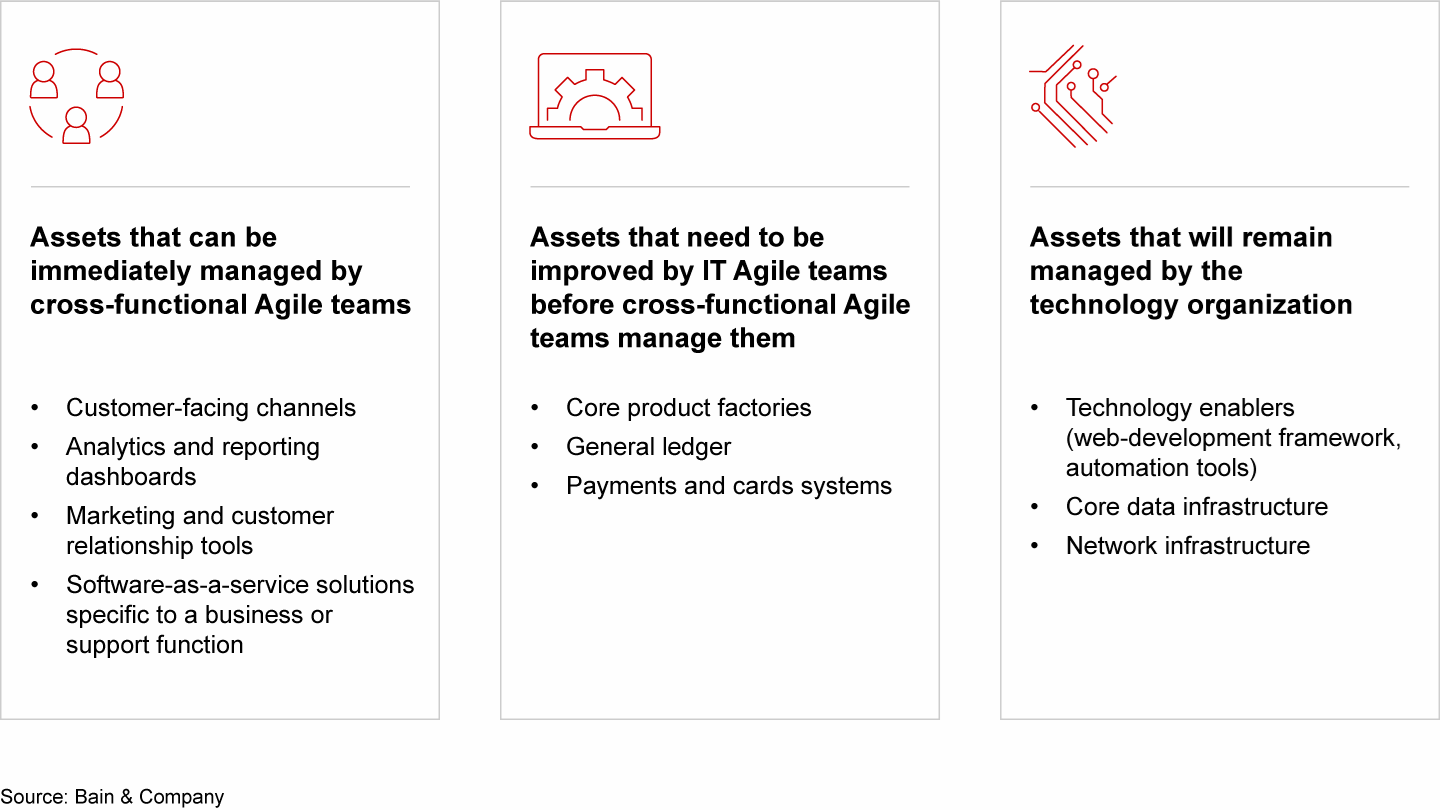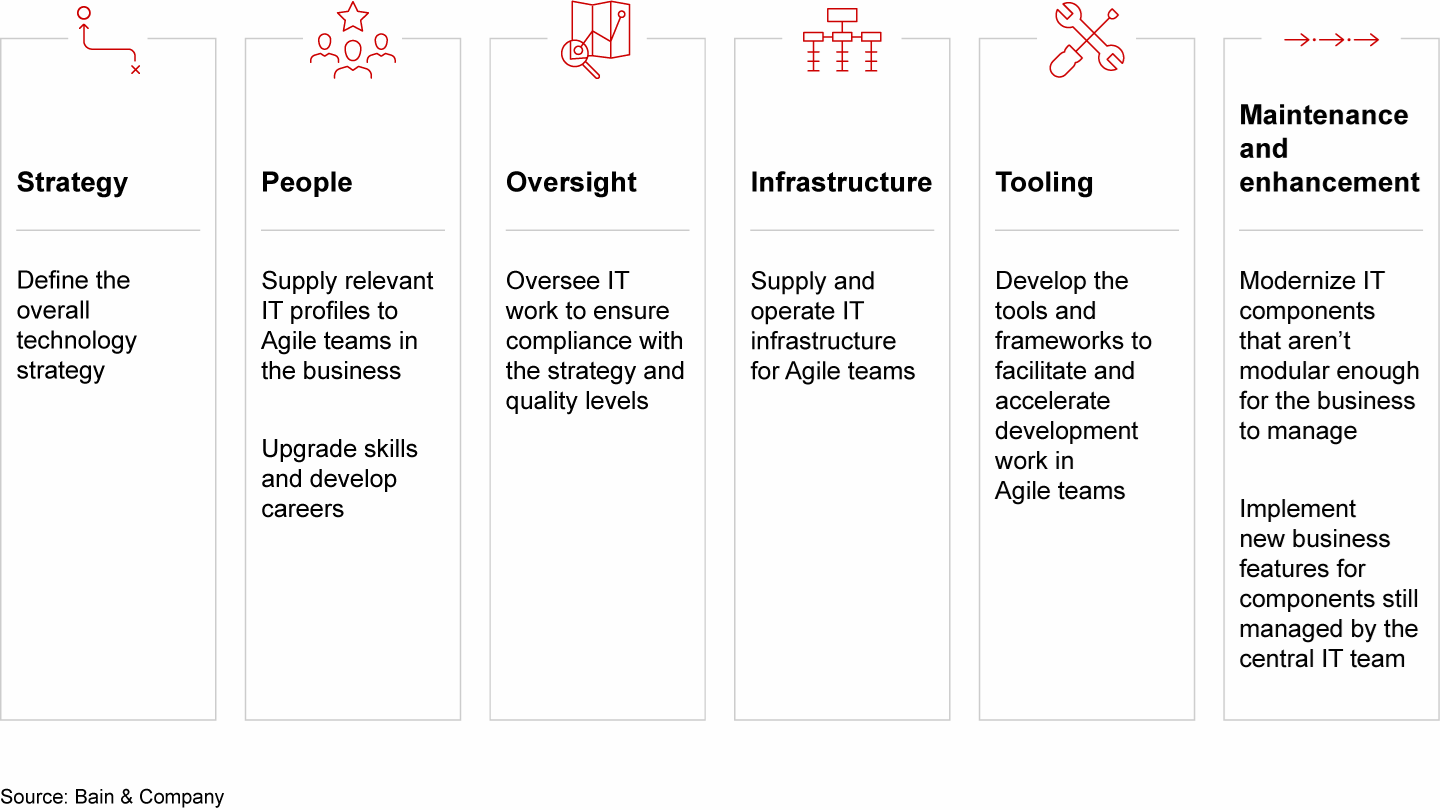Brief

Резюме
- Agile development in financial services firms has mostly remained within IT departments, which means the firms struggle to assemble truly cross-functional teams that can deliver working solutions every few weeks.
- As a result, they’re falling short of full potential in speed, quality, cost, and customer satisfaction.
- Some banks and insurers, however, have managed to transition to cross-functional Agile teams.
- These institutions typically extend Agile throughout the enterprise in three phases: establishing the foundations; organizing around IT assets’ Agile readiness; and pushing the broader Agile agenda.
The past year or so has seen a significant increase in companies using Agile practices outside the traditional IT domain. Agile adoption in non-IT lines of business has doubled in 2021 from the year-earlier period, Digital.ai reports.
Many companies have come to recognize that they can continuously improve products and services by employing the Agile method, which creates small, cross-functional teams that operate in short “sprints” to develop and test solutions to discrete problems. Yet Agile development within banks, insurers, and other financial services firms traditionally has originated and remained in technology departments. These firms have struggled to assemble truly cross-functional teams, composed of both business and IT people, and gather all of the competencies required to deliver working solutions every few weeks. The orchestration challenge is not trivial.
Expanding Agile beyond the IT incubator is a critical feature of high-performing Agile enterprises. In Bain’s Agility Quotient survey of more than 1,000 companies, the vast majority of top-performing companies agree that “our technology people are proficient enough on business and strategy—and our business people are versed in technology topics.”
Consider the experience of a global insurer. The IT department was an early adopter of Agile ways of working, adjusting its internal operating model while preserving established processes and interfaces with the rest of the organization. Each team was led by a proxy product owner—an IT member who gathered business needs and fed IT teams.
Although Agile methods within IT made for shorter cycles in project development, testing, and sometimes deployment, the insurer kept Agile in the IT silo. Several problems have persisted:
- low business-unit involvement, with requests sent to IT that forced an iterative waterfall approach;
- rigid planning and budgeting of new initiatives;
- support and control functions hindering rather than maximizing throughput; and
- a command-and-control culture that undermined creativity and innovation.
The early successes of Agile in IT, combined with the desire to address the persisting challenges, led the company to pilot end-to-end agility on a small set of initiatives that will catalyze a broader transformation.
For companies that have successfully expanded Agile out of the IT silo, the benefits have been substantial. A large UK bank has been rolling out a cross-functional model throughout its business areas, with dramatic results: Over a 3-year period, the bank’s Net Promoter Score℠ has risen 5 points, employee engagement scores have risen by 9 points, the cost-to-income ratio has dropped by one-third, and the return on equity has more than doubled.
Impediments to Agile expansion
Several reasons typically account for the slow transition to fully cross-functional Agile teams. When the head of IT for a pan-European bank’s local entity sought to expand Agile practices beyond the technology group, he faced significant hurdles:
- IT was still viewed by the business units as the weakest link to improving products and services, fostering a silo mentality.
- Technology teams were organized along IT assets, while business teams were organized along products and business areas, which prevented an end-to-end understanding of how to deliver value to customers.
- The head of IT had no mandate to interfere with business operations, despite poor business-IT collaboration.
- It was unclear how the IT group’s Agile transformation could be parlayed to expand Agile practices across the business units.
Fortunately for this bank, the group COO, the entity CEO, and the executive committee had learned enough about Agile in other industries that they saw the potential of integrating business and IT into cross-functional Agile teams. They were convinced this would yield benefits in speed, quality, cost, and customer satisfaction.
How a bank broke through
The bank’s expansion from Agile in IT to Agile throughout the enterprise took place in three phases.
Establishing the foundations. Business leaders of the bank developed a taxonomy of customer experiences, which guided the organization of Agile teams. At the same time, the technology architects assessed the readiness of IT assets, sorting them into three categories (see Figure 1):
- assets that support a well-defined set of customer experiences and meet specific agility criteria, hence can be immediately managed by cross-functional teams, such as customer-facing channels;
- assets that support a well-defined set of customer experiences but don’t fully meet agility criteria, hence must be improved by IT teams before they can be managed by cross-functional teams, such as core product factories; and
- assets that support a broad set of experiences, require a specific technology expertise, or enable technology, and thus will remain managed by the IT group, such as a web-development framework.
IT assets can be assessed on their Agile readiness


Organizing around IT assets’ Agile readiness. Based on the taxonomy of customer experiences and Agile maturity of IT assets, the bank’s business and IT teams started to reorganize. Cross-functional teams were established to handle the more Agile IT assets. Some existing IT teams focused temporarily on modernizing assets that weren’t fully Agile-ready, then transitioned into cross-functional teams. Other IT teams remained focused on IT assets that didn’t need to be managed by cross-functional teams.
Across all the teams, the bank established “communities” of people with common technical or business expertise, led by a senior individual of the community, and reporting to their respective functional leader. For instance, IT-related communities composed of analysts, developers, and testers report to leaders in the IT function, while business-related communities such as product owners, marketers, and user-interface designers report to leaders in the business functions.
Pushing the broader Agile agenda. Achieving the full benefits of agility at scale required the IT department and the whole bank to embrace a much broader change agenda than just setting up Agile teams.
To cite a few examples, the bank needed to use technology to accelerate development work, through standard and cutting-edge components, application programming interfaces, and other means. The general mindset had to shift from “projects” to a “product teams and backlogs.” Agile management processes had to catch on at the corporate level, in order to make decisions on strategic priorities, budgets, and other issues. Rather than waiting to review and amend project requirements, the support functions had to actively contribute to sprint planning and backlog refinement. Moreover, Agile practices had to involve the network of external suppliers.
Early pilots of these cross-enterprise Agile initiatives demonstrated a clear potential for the bank to achieve its ambitions on revenues, profits, and employee engagement.
IT’s role changes
Throughout an Agile transformation, the role of the IT organization typically gets reshaped according to six themes (see Figure 2): defining the overall technology strategy; supplying and upgrading the skills of IT talent across Agile teams; overseeing technology activities performed by Agile teams to ensure compliance with strategy and quality standards; supplying and operating the required technology infrastructure; developing the tools and frameworks to facilitate the IT work performed by Agile teams; and enhancing and maintaining the less-Agile IT assets.
The role of the IT group evolves as Agile expands across the enterprise


Agile may have taken root in the IT function of financial services firms, but now it needs to bust through the walls. An end-to-end Agile operating model depends on close collaboration of technology and business units. Strong sponsorship by senior executives will be required to help the organization navigate this transition, but it’s well worth the effort.
Net Promoter®, NPS®, and the NPS-related emoticons are registered trademarks of Bain & Company, Inc., Satmetrix Systems, Inc., and Fred Reichheld. Net Promoter Score℠ and Net Promoter System℠ are service marks of Bain & Company, Inc., Satmetrix Systems, Inc., and Fred Reichheld.